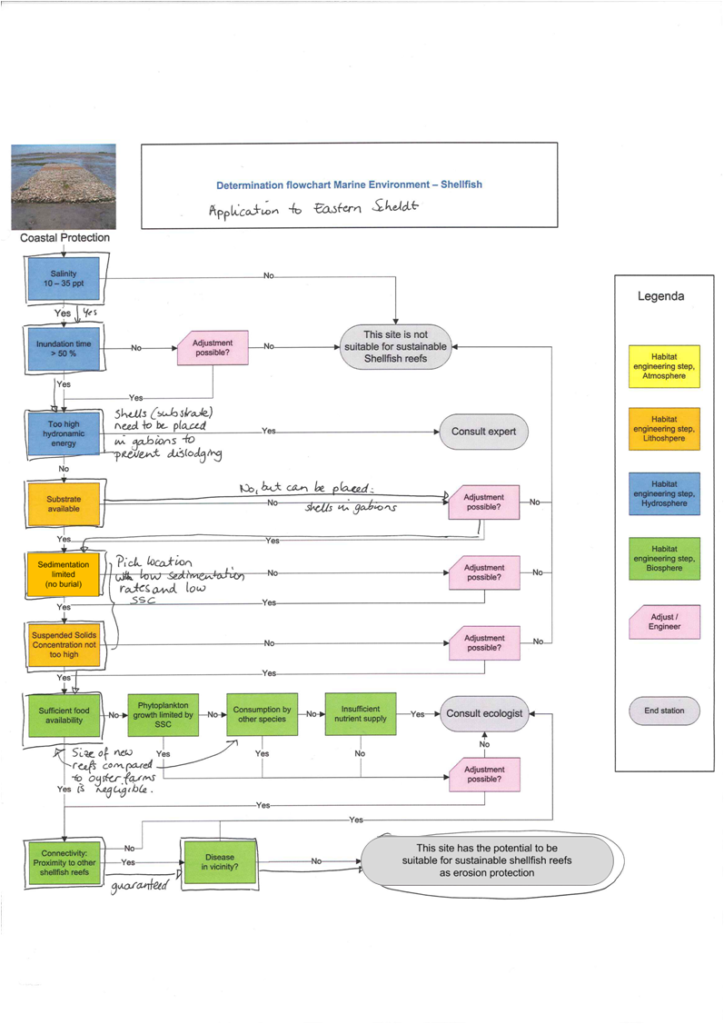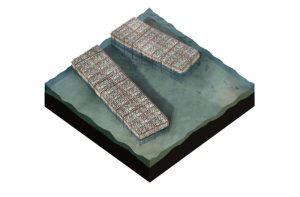Practical Applications
This section describes the application of the Concept to a practical case. The study area for this application is the Eastern Scheldt (SW Netherlands). A separate Project Shellfish reefs page exists, which describes the phases in the design and construction process of the oyster reefs in the Eastern Scheldt. In the practical application described on this page, the flowchart is discussed by explaining and applying the text and values in the balloons.
Fill in determination flowchart

Following the determination flowchart, the aim is to determine the critical habitat requirements for oysters in the Eastern Scheldt. For each parameter in the chart, information on the specific project location is needed. The following sources of information can be considered to obtain site-specific values for these parameters:
- Current state of the ecosystem on site (occurrence of species/health of species present).
- Available literature.
- Computational Modelling.
- Data collection (measurements/field work).
The hierarchy above is based on the amount of effort it usually takes to obtain information from the specific source. However, the effort can differ significantly due to factors such as local knowledge, circumstances on site, availability of measuring equipment, etc. For the Eastern Scheldt case, information is abundant as basic data on salinity, waves and water levels are available on the internet (at government websites) and experience with the construction of artificial oyster reef substrates exists.
In the following section, the flowchart is discussed from top to bottom to give the rationale concerning each habitat requirement.
Salinity – Salinity in the Eastern Scheldt is suitable for the Pacific Oyster. Salinity is in the range of 25 and 35 ppt (Davis et al., 1962, Schellekens et al., 2011). In the Netherlands, this type of data is measured and made available through a national monitoring program (MWTL – Monitoring Waterstaatkundige Toestand des Lands).
Inundation time – Inundation periods vary along the slopes of the intertidal flats. The height of a flat is depending on the local hydrodynamics. Oyster reef substrate can be placed at such a level that the inundation time is optimal. In the case of the Eastern Scheldt an exposure time of less than 30% is optimal for the oysters, while exposure time above 50% is unsuitable (Schellekens et al., 2011). This implies that artificial reefs should not be placed outside this range.
Hydrodynamic energy – In the Eastern Scheldt oyster reefs are not observed at sites with current velocities larger than 50 cm/s (Schellekens et al., 2011). This implies that artificial reefs placed at more dynamic conditions need additional fixation of the substrate. Experiments with loose oyster shells at an exposed site (Dortsman) resulted in the complete loss of the shells during stormy conditions. Here the hydrodynamic energy (mainly waves) was too high to place shells without fixation. Therefore, the use of gabions filled with oyster shells was introduced. Attachment of oyster larvae is usually not limited by hydrodynamics, but dislodging of substrate can pose a significant problem. Storm events, may destroy initially successful settlement of oyster larvae, thus preventing sustainable reef creation.
Substrate available – In the Eastern Scheldt, oyster reefs nowadays occupy about 10% of the intertidal habitat (Smaal et al. 2009). Substrate (e.g. shells of cockles, oysters) is available throughout the Eastern Scheldt, but at exposed and eroding sites a more fixed substrate needs to be present to allow for an oyster reef to develop. Therefore, the use of gabions filled with oyster shells is required at these sites. Research has shown that dead oyster shells are the preferred substrate for settlement.
Sedimentation – Burial of oysters will lead to mortality and slow development or possible disappearance of the reef. Too high sedimentation rates are therefore limiting. The pilot in the Eastern Scheldt showed that this can be a problem, depending on location of the reefs and the meteorological circumstances (storm events).
Suspended sediment concentration – In the Eastern Scheldt suspended sediment concentrations are very low (on average < 25 mg/l), and therefore is not a limiting factor for oyster growth. However, in other systems too high SSC can clog the gills of oysters and result in mortality.
Sufficient food availability – Because of the high primary production in the Eastern Scheldt, the area is an important shellfish culture area (mussels, oysters) (Smaal et al. 2013). A concern was raised that additional reefs for coastal protection purposes would affect the carrying capacity of the Eastern Scheldt for shellfish. In the case of the present experiments (Project Shellfish Reefs), calculation led to the conclusion that their effect on the carrying capacity in the Eastern Scheldt is marginal. However, when applied on a large scale, the possible influence on the carrying capacity must be considered.
Connectivity – Proximity to other shellfish reefs of the same species, in this case the Pacific Oyster, is important for the supply of larvae. Supply of larvae in the Eastern Scheldt is guaranteed by the presence of natural reefs and cultured oysters.
Disease in the vicinity – Until recently there were no diseases in the area, as far as known from experience of the oyster farmers in the region. However, in 2010 the oyster herpes virus was detected in the Eastern Scheldt. In addition, the predatory neogastropod the Japanese (Ocinebrellus inornatus) and American oyster drill (Urosalpinx cinerea) are found in the Eastern Scheldt.
Conclusion
Due to the experiments already conducted in the Eastern Scheldt a lot of information is available. It appears that location in combination with suitable hydrodynamic conditions is critical to the successful creation of sustainable oyster reefs there. In addition, appropriate substrate (preferably dead oyster shells) needs to be placed to allow settlement of larvae. Experiments have shown gabions are most suitable to keep the shellfish-substrate in place.

